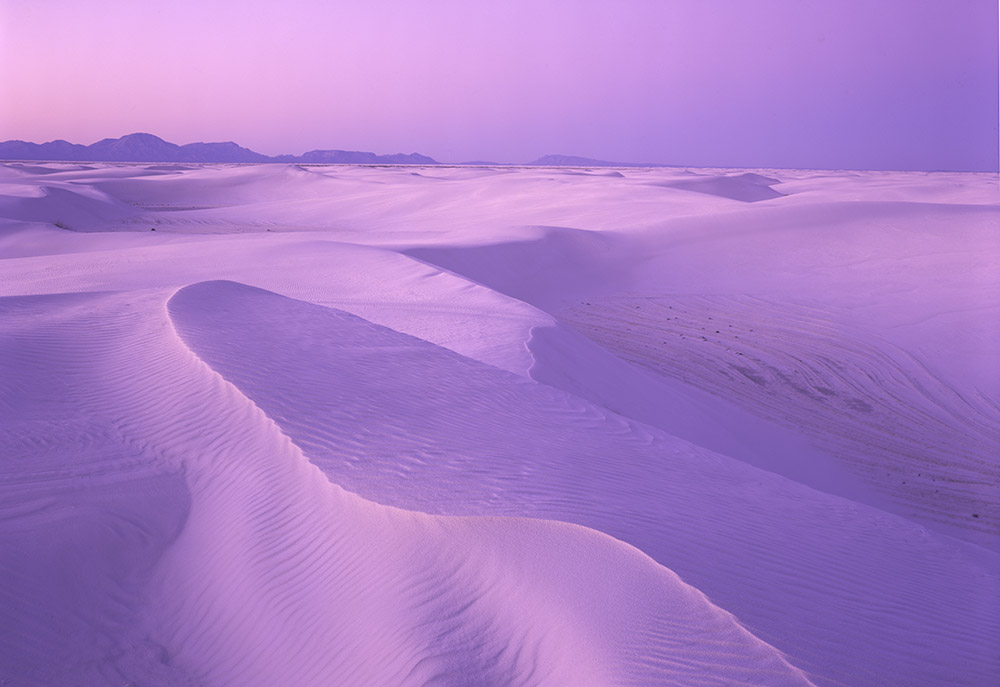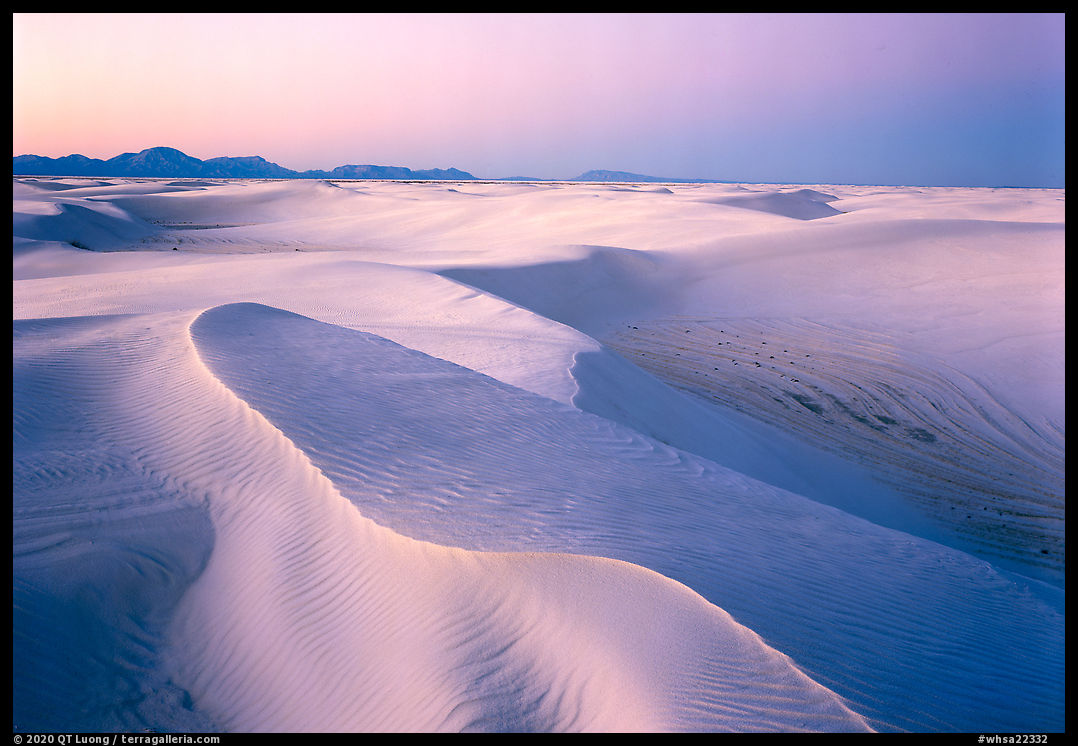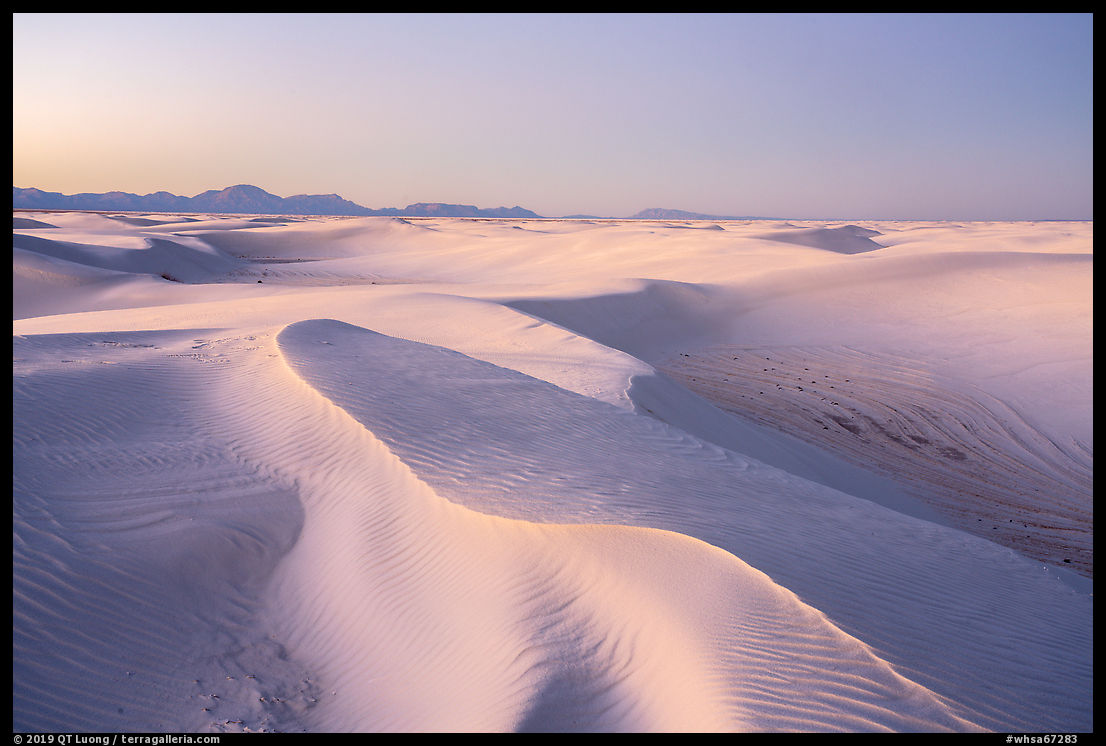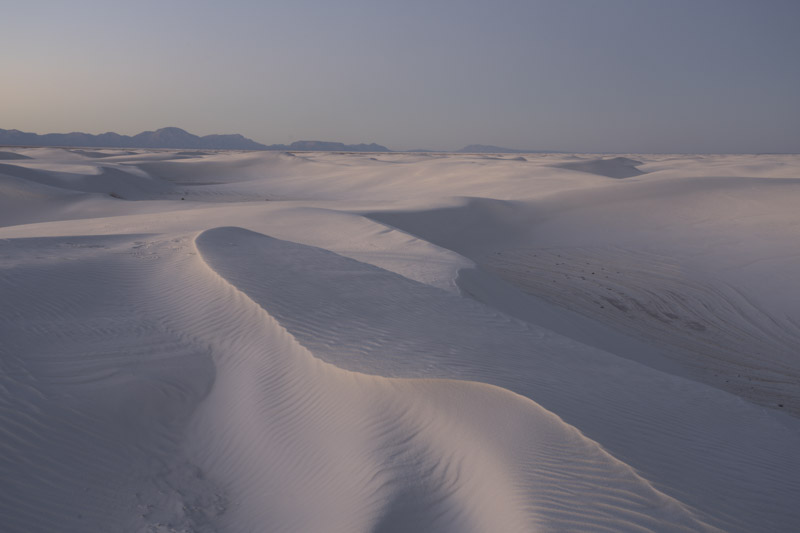White Sands Dusk: Film versus Digital
15 Comments
My only goal for the afternoon of December 20, 2019, was to make one photograph that I had been working towards since I arrived at White Sands National Monument, two days before: the ocean of white dunes colored by soft light of dusk, on the evening it would redesignated the 62th national park. It would have to be photographed on 5×7 large format film. More than a quarter-century before, what inspired me to start my national parks quest was the prospect to be the first to photograph all of them on 5×7 film. As national parks #59 (Pinnacles), #60 (Gateway Arch) and #61 (Indiana Dunes) were added, I continued that streak, and I had traveled to New Mexico to keep this aspect of project continuity alive.
There was only one composition because by the time I completed the exposure, after waiting for the sky overhead to become dark enough that most of the illumination would come from the western horizon, bringing strong directionality to the light, it was too dark to recompose and focus on the ground glass. There is no preview in the camera, and it was not until long after the journey has ended that I could hold into my hands the result. Before that moment, I had to unload my film holders into a light-proof film box, mail it to a processing lab (no lab in the San Francisco Bay Area deals anymore with the finicky large format transparency film), and wait with a mixture of anxiety and trepidation for the transparencies to be shipped back. When I placed the transparency on the light table, I was astonished by the color. This is the uncorrected scan.

Although the film I had been using had an expiration date in the 20th century, I had kept it frozen all the time. I had bought a second freezer just for the purpose of storing that film now long discontinued. The images I made earlier in the day did not exhibit any noticeable color shift, so I assume the film performed normally, and that’s just how it rendered the fading quiet light with a long exposure. The film has been physically there, and did what it was supposed to do, so that’s one truth. I thought it was beautiful, but eventually, I worried that the way it interpreted the scene looked too surreal. After closing my eyes, I tried to remember what the sunset felt like on this evening, another truth. Using Photoshop I neutralized some of the color cast with a level (individual channels) adjustment layer and a color balance adjustment layer, then increased the contrast with a curve layer, resulting in the finished file below.

For comparison, here is the finished digital photograph that you saw in previous blog posts. That exposure is also an interpretation of the scene, resulting from contrast adjustments in Lightroom (Exposure -0.20, Contrast -20, Highlights -80, Whites +70, Blacks -50) with +10 Clarity and Vibrance and a medium contrast curve. Although done independently, and with a different piece of software, they produced a result with striking similarities, but noticeable differences. A performer is indeed identified by his performance, no matter the scores. The choice of color balance (Temp 6,900), resulted in a warmer rendition. I didn’t feel like going as far with the film image because of the place where it started.

There is as much difference between the finished digital photograph and the RAW file below as there is between the scan and its derived finished file, with the RAW file looking much duller.

The film was 5×7 Fuji Astia, while the digital was the Sony A7R mk4. Both have enough dynamic range, and if you inspect the transparency and file, you’d find that film has a small edge in detail.
Film versus Digital
Since the introduction of the first practical DSLRs at the beginning of this century, there has been endless film versus digital debates, with often passionate arguments for both sides. Since I’ve never chimed in, I though that you may be interested in my current thoughts on the matter. I am well-placed to have an objective opinion since I am part of both camps. I’ve photographed on large-format film since 1993 and occasionally continue to do so, with the same camera in all those years. Having added to my arsenal a 3MP Nikon Coolpix 990 in 2000, 6MP Canon EOS 300D in 2003, and 16 MP Canon EOS-1Ds mk2 in 2004, I think I can fairly claim to have been an early digital photography adopter – although second-generation because I don’t feel the need to beta-test at my cost.
Digital photography proponents often argue that digital is far superior. The metrics being considered are not always mentioned. While this was not always the case, in 2020, I agree with that statement for all the practical metrics: flexibility, ease of learning and use, portability, workflow speed, image quality for a comparable format, and total cost for a reasonably prolific photographer. So besides specialized uses (alternative processes, very long exposures, panoramic formats, etc…), why would one want to use film?
With one exception, this would be for intangible reasons, which, while not easily quantified or measured, are nevertheless real. That exception would be absolute image quality in a single shot, because while digital nowadays provides much higher resolution for a given format (for example full-frame vs 35mm), the largest digital sensors are limited to about 2.3 x 1.7 inches (6cm x 4.5cm, the film 645 smaller “medium format”) while 8×10 inch cameras and film are readily available. If high resolution is desired, when the cost of the high-end digital medium format systems is factored in, large-format film becomes a sensible proposition for the art photographer whose production volume is limited. Before the 2019 Fuji 100 GFX, no sensibly priced camera matched the resolution of 5×7 film.
I emphasized “single shot” because if multiple image techniques are applicable and acceptable, then all the technical advantages of large format cameras can be overcome by compositing. Not enough resolution? Assemble images into a panorama. Not enough depth of field without the tilt controls provided by large format cameras? Focus stack. Unsufficient dynamic range or abrupt highlight clipping (compared to negative film) ? HDR. However, all those techniques rely on post-processing and take the digital workflow even further from the film workflow.
That workflow is one of the main reasons for working with large format film in this day and age. This type of photography encourages a deliberate approach that places a priority on planning, selectivity, composition, and execution in the field. I was initially attracted to large format photography for technical reasons, but in retrospect, what mattered the most was the discipline I learned and the resulting growth. The way of working retains a distinct purity and materiality.
Even with smaller formats, the results are different because film has a different way of responding to light than digital, as the example in this post has illustrated. Something seemingly as simple as the way Fuji transparency film such as Velvia or Astia reproduces colors turns out to be very difficult to replicate with digital tools. Before the advent of digital photography, when the silver gelatin print was the standard, there were a number of practitioners of “alternative processes”, which was anything but silver gelatin. Nowadays, all analog processes are alternative. In artistic pursuits, it can be beneficial to do something different from what the mainstream is doing, and at the same time to be working in a process steeped in the history and traditions of the medium.
As mentioned before, all of this is quite intangible, but there is one area where things could be quantified. If you look at the landscape work done at the upper echelons of art photography, by which I mean recognized by art institutions such as museums and galleries, I think you will find that compared to mainstream photography, a disproportionate amount of it is still done using film. Maybe there is a good reason?


Great article. I’ve been spending a lot of the sheltering time digging up transparencies from way back, mostly 35mm but some medium format, and scanning them on a Nikon 9000. I’ve been wrestling with the vagaries of scanning and the differences between the mediums. You captured a lot of the issues very well. Thanks.
The color shift in your Fuji film shot appears to be the result of reciprocity failure. I experienced similar shift in hue on long exposure on Fuji film similar to Astia back in my film days.
For those who are too young to remember that photography used to be a chemistry experiment (vs. a physics experiment in modern digital camera), reciprocity failure occurs when the rate of photons striking silver halide crystals is too slow (as in low light long exposure shots) to produce the same color response determined by the reciprocity law of light intensity x time. The breakdown in the linear tradeoff between exposure and shutter speed is known as reciprocity failure.
Exactly. Although based on what I remembered, the extent of the shift surprised me.
Ditto. It seems extreme. I recall Fujichrome going purple in reciprocity failure, and having to be somewhere over a minute for it to start. But I’m sure the chemistry has changed in 20 years. I wonder if that hue has more to do with the film spectral response? The data sheet for Astia lists the compensating filter for reciprocity as 5B, which I think is blue. Interesting. Try it again on purpose?
For me, and I’d guess that for you as well, you ultimately seem to be interested in your work being presented for viewing NOT via a monitor, its not HOW you get there so much as presenting what YOU saw.
Yes, but some ways of getting there are more satisfying than others. The journey does matter, if not to the viewer, at least to the photographer.
I enjoyed seeing the differences and what you thought. Having started out in film for many years and my husband still works with large format B&W up to 7 x17 this was very interesting. Even in the small presentations of the photos you can see that the film one has an edge on detail over the digital. I went mostly digital for the ease and amount of photos I could easily take but I agree that film is superior if you really want a high standard image. Congrats on shooting all the NPs on 5×7. Quite an accomplishment.
Hi Shelly.. nice seeing you here 🙂
I think to me the biggest insight is the comparison of a single film large-format shot vs. either stacked focus or composite shots in digital.
That to me, is two different worlds. I’m amazed at the level of detail in film prints, especially versus early digital captures.
I’m spoiled now when even my phone camera will take HDR composite and panoramas of decent quality.
Thanks for capturing the beauty of the National Parks in 5×7 it will be a record we can enjoy forever.
Once multiple-image captures became practical, I felt the technical reasons for using large format film for making large prints diminished greatly. The paradox is that for small prints, analog process retain an edge. Although no reasonable viewer would do that, If you look at a contact print through a loupe, you’ll see an endless amount of detail, whereas with a digital print, you’ll see pixels.
Thanks very much for a most interesting article.
You mentioned that “film has a small edge in detail.” As you know the resolution of the image depends on both the resolution of the film/sensor and the lens. I would be grateful if you could tell me which lenses were used in the comparison. Thank you.
Film: Schneider Apo-Symmar 210mm f/5.6. f/32
Digital: Sony FE 24-105mm f/4 @ 42mm. f/16.
While the later is an excellent all-purpose lens, there are sharper ones, however the difference would be leveled by the diffraction at the shooting aperture.
Thank you for the lens information. I believe this indicates that the depth of field for the digital image is signifcantly greater than that for the transparency, assuming no lens movements were made on the view camera during focussing. If the Sony lens aperture is opened about 2 stops, this would make the depth of fields similar and would also significantly improve the resolution of the lens as well as reducing diffraction effects. Consequently I would humbly suggest that if no camera movements were made, the digital image is at a disadvantage with regard to resolution in this comparison.
Tilt was used, as is almost always the case when there is no significant height in the foreground. In support of your point, f/45 would have been better as the areas in the depression on the right, which are below the focus plane, were a bit soft. Anyways, that was not meant to be a set up for a rigorous comparison, if you want to read about one, refer to Tim Parkin’s work: https://www.onlandscape.co.uk/2020/02/8×10-film-vs-iq4-150mp/
Thank you for the clarification. Yes, I am familiar with Tim’s work. I look forward to more of your articles.